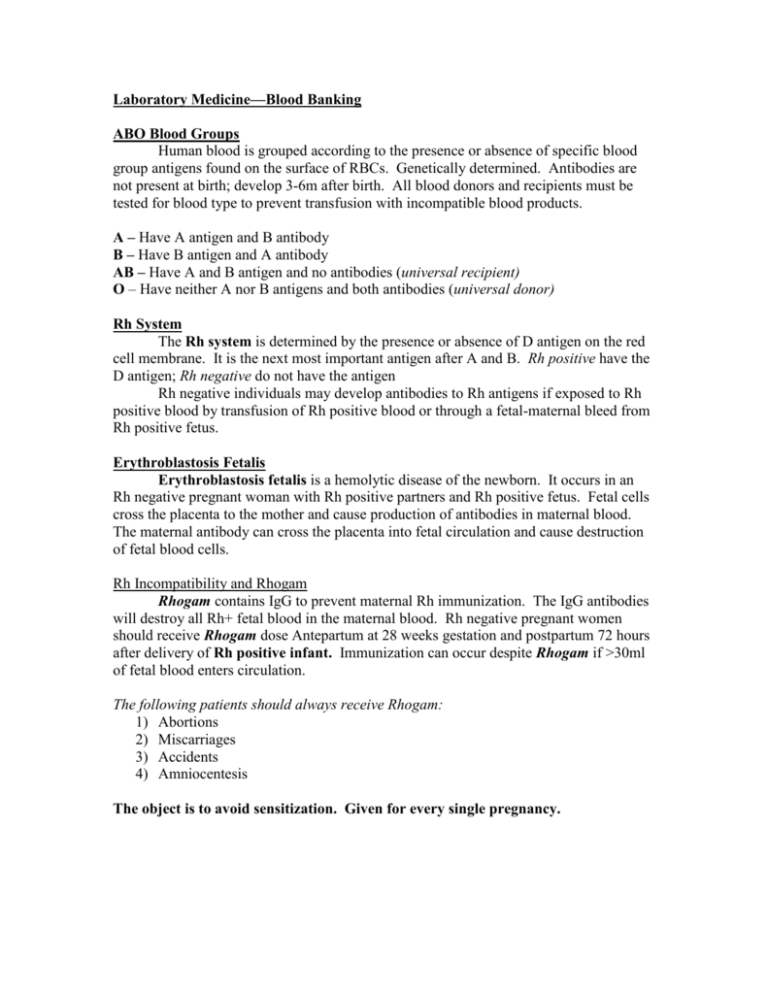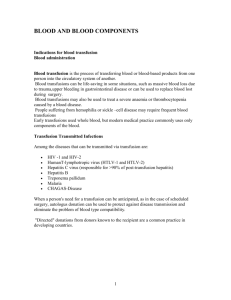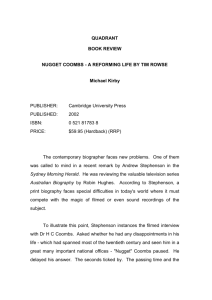Laboratory Medicine--Blood Banking
advertisement

Laboratory Medicine—Blood Banking ABO Blood Groups Human blood is grouped according to the presence or absence of specific blood group antigens found on the surface of RBCs. Genetically determined. Antibodies are not present at birth; develop 3-6m after birth. All blood donors and recipients must be tested for blood type to prevent transfusion with incompatible blood products. A – Have A antigen and B antibody B – Have B antigen and A antibody AB – Have A and B antigen and no antibodies (universal recipient) O – Have neither A nor B antigens and both antibodies (universal donor) Rh System The Rh system is determined by the presence or absence of D antigen on the red cell membrane. It is the next most important antigen after A and B. Rh positive have the D antigen; Rh negative do not have the antigen Rh negative individuals may develop antibodies to Rh antigens if exposed to Rh positive blood by transfusion of Rh positive blood or through a fetal-maternal bleed from Rh positive fetus. Erythroblastosis Fetalis Erythroblastosis fetalis is a hemolytic disease of the newborn. It occurs in an Rh negative pregnant woman with Rh positive partners and Rh positive fetus. Fetal cells cross the placenta to the mother and cause production of antibodies in maternal blood. The maternal antibody can cross the placenta into fetal circulation and cause destruction of fetal blood cells. Rh Incompatibility and Rhogam Rhogam contains IgG to prevent maternal Rh immunization. The IgG antibodies will destroy all Rh+ fetal blood in the maternal blood. Rh negative pregnant women should receive Rhogam dose Antepartum at 28 weeks gestation and postpartum 72 hours after delivery of Rh positive infant. Immunization can occur despite Rhogam if >30ml of fetal blood enters circulation. The following patients should always receive Rhogam: 1) Abortions 2) Miscarriages 3) Accidents 4) Amniocentesis The object is to avoid sensitization. Given for every single pregnancy. Blood Transfusions Indicated for: 1) Surgery 2) Acute blood loss 3) To raise hemoglobin for anemias – if hemoglobin <8g/dL or hematocrit <24% Blood should be screened for minor blood group antibodies with indirect Coombs test. Blood Cross-Matching Blood screen looks for antibodies A, B, Rh, kelly, kidd, and duffy. Clumping, or agglutination, signifies an incompatible response. Cross-matching identifies a mismatch of blood caused by minor antigens. If antibody is found, blood must be given without that antigen. Mix the recipient’s serum with the donor’s RBCs in saline solution followed by addition of Coombs serum (indirect Coombs). The plasma does not need to be cross-matched but ABO compatible. Blood Typing Blood typing determines which antigen is on the RBC and which antibody is in the serum. Blood is mixed with three different reagents including any of the three different antibodies A, B, or Rh. Must look for agglutination. If blood agglutinates when mixed with anti-A, it signifies that the blood type is A. Type O has no agglutination. Coombs Test There are two types of Coombs test: direct and indirect. It identifies hemolysis or transfusion reactions. Normal should have negative agglutination. Detects antibodies. Direct Coombs Test In direct Coombs test, plasma is washed off the patient’s RBCs. Cells are then placed in a medium with antibodies against human immunoglobulin. This evaluates the presence of antibodies on the surface of RBCs themselves instead of serum. It is more sensitive than indirect Coombs. Positive antibodies equal positive Coombs. It detects antigen-antibody complex coating of the RBC. Tries to identify the cause of jaundice or anemia. Any clumping at all is a positive response. Indirect Coombs Test Indirect Coombs test detects if the patient has circulating antibodies against RBCs in the serum. Looks for minor antibodies. This is the screening portion of blood typing and screening. Performed on the patient’s serum, not the RBCs. The recipient’s serum is added to the RBCs to be transfused. Coombs serum (antibodies to human globulin) is then added to RBCs. Positive reaction is clumping. Patients will have reaction to blood about to be transfused if Coombs is positive. Ordering 1) Type and hold 2) Type and screen – indirect Coombs testing. Done for pre-op situations and pretransfusions. Looks for antibodies. 3) Type and cross with # units – standardization of blood amounts (250-300ml/unit of blood). Looks for potential antigens. Transfusion Reactions Acute Hemolytic Reactions Acute hemolytic reactions are severe reactions involving mismatches in the ABO system. Often due to clerical error. Hemolysis is rapid and involves intravascular releasing of free hemoglobin. Very severe cases can lead to dyspnea, hypotension, and vascular collapse (same as hemorrhagic shock). Donor blood and patient blood should be re-cross-matched to identify infused products. STOP TRANFUSION IMMEDIATELY! Looks for free hemoglobin in the plasma. Hydrate the patient. Complications include DIC, acute renal failure from tubular necrosis. Both can also occur. Febrile Reactions Febrile reactions are the most common. Risk increases with the number of previous transfusions received. The presence of leukoagglutinins (antibodies against WBC) and donor WBC leads to release of pyrogens. Core temperature increases by 1 degree Celsius or more with no evidence of hemolysis within 6-12 hours. Severe cases can lead to cough, dyspnea, and pulmonary infiltrate. The reaction is benign and can be prevented by using leukocyte-poor blood. DO NOT STOP TRANFUSION! May premedicate with acetaminophen or use leukocyte-poor blood in the future. Anaphylactic Reaction Anaphylactic reaction is an IgE-mediated response to plasma proteins rather than WBC in donor blood. Clinical features include local urticaria, dyspnea, and hypotension. Utilize transfusion of washed or frozen RBCs to avoid future severe reactions. Stop the reaction and use antihistamines like Benadryl or corticosteroids. Contaminated Blood/Sepsis Contaminated blood usually occurs with gram-negative bacteria. Can lead to septicemia and shock from endotoxins. The offending unit should be cultured. Treated with antibiotics. Disease Transmission Transfusion-associated viral diseases can be transmitted from patient to patient. Blood donors are screened for HBV, syphilis, p24 antigen and antibody to GIV, antibody to HCV, and antibody to West Nile Virus. Circulatory Overload Circulatory overload occurs when the volume and colloid is in excess of what a patient with compromised cardiovascular function can handle. Clinical features include tachycardia, dyspnea, and hypoxia (CHF). Treatment is the slow administration of blood and diuretics. Rapid and massive transfusion of cold blood can cause hypothermia and hypocalcemia Diagnosis/Lab Tests 1) CBC 2) Direct Coombs Test 3) UA – for hemolyzed blood. May find Urobilinogen (product of bilirubin after it has gone through the kidney) 4) Serum haptoglobin levels – identifies intravascular hemolysis. Haptoglobin is produced by the liver and binds up free hemoglobin. Hemolytic states will have decreased haptoglobin. 5) Return blood bag with tubes attached and label 6) Might have to fill out transfusion reaction form Platelet Transfusions Platelet transfusions are indicated in cases of thrombocytopenia due to decreased platelet production. Not useful in immune thrombocytopenia because these platelets also will not last long. There is a risk of bleeding if platelet levels are 5,000-10,000. Platelets can be given prior to invasive surgical procedures. One unit can raise platelets by 10,000 for 2-3 days. White Blood Cell Transfusions Only two types of patients benefit from white blood cell transfusion: 1) documented bacterial, especially gram-negative, infections with persistent neutropenia 2) lack of response to antibiotic therapy. Transfusion must be given soon after collection. Side effects include febrile reaction. Transfusion of Plasma Transfusions of plasma (whole blood minus cells) contain normal levels of all coagulation factors. Used to correct coagulation factor deficiencies and to treat TTP. Cryoprecipitate is made from fresh plasma. It is used to supplement fibrinogen in cases of congenital deficiency of fibrinogen and DIC. Blood Products for Transfusion 1) Fresh Whole Blood – RBCs, plasma, and platelets. Indicated in exsanguinations. 2) Packed RBCs – whole blood minus plasma. Treatment of choice in anemia and hemorrhages. 3) Leukocyte-poor Blood – removal of WBCs and platelets 4) Washed RBCs – reduced risk of febrile and allergic reactions to plasma proteins 5) Autologous PRBCs – used for operation. Your own blood is transfused back into you 6) Frozen RBCs – prolonged preservation of RBCs with rare blood types or Autologous donation 7) Platelets 8) Granulocytes 9) Plasma components – coagulation factors 10) Fresh-frozen plasma – fresh-frozen factors 11) Cryoprecipitate – deficiency of fibrinogen and factors VIII or XIII.






